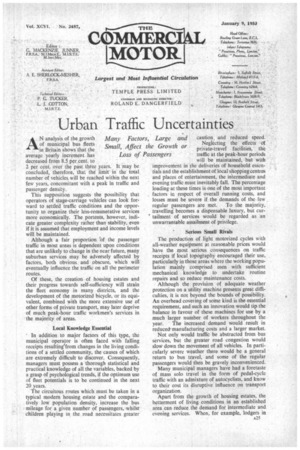Urban Traffic Uncertainties
Page 27

Page 28

If you've noticed an error in this article please click here to report it so we can fix it.
N analysis of the growth of municipal bus fleets in Britain shows that the average yearly increment has decreased from 8.5 per cent. to . 2 per cent. over the past three years. It May be concluded, therefore, that the limit in the total number of vehicles, will be reached within the next few years, concomitant with a peak in traffic and passenger density.
This supposition suggests the possibility that operators of stage-carriage vehicles can look forward to settled traffic conditions and the opportunity to organize their less-remunerative services more economically. The portents, however, indicate greater complexity rather than stability, even if it is assumed that employment and income levels will be maintained.
Although a fair proportion "of the passenger traffic in most areas is dependent upon conditions that are unlikely to change in the near future, many suburban services may be adversely affected by factors, both obvious and obscure, which will eventually influence the traffic on all the perimeter routes.
Of these, the creation of housing estates and their progress towards self-sufficiency will strain the fleet economy in many districts, and the development of the motorized bicycle, or its equivalent, combined with the more extensive use of other forms of private transport, may later deprive of much peak-hour traffic workmen's services in • the majority of areas.
Local Knowledge Essential In addition to major factors of this type, the municipal operator is often faced with falling receipts resulting'from changes in the living conditions of a settled community, the causes of which are extremely difficult to discover. Consequently, managers must possess a thorough statistical and practical knowledge of all the variables, backed by a grasp of psychological trends, if the optimum use of fleet potentials is to be continued in the next 20 years.
The circuitous routes which must be taken in a typical modern housing estate and the comparatively low population density. increase the bus mileage for a given number of passengers, whilst children playing in. the road necessitates greater caution. and reduced speed. Neglecting •the effects private-travel facilities, the traffic at the peak-hour periods will be Maintained, but with improvement in the deliveries of household essentials and the establishment of local shoppingcentres and places of entertainment, the atermediate and evening traffic must inevitably fall. The percentage loading at these times is one of the most important factors in respect of overall running costs, and losses must be severe if the demands of the few regular passengers are met. To the majority, travelling becomes a dispensable luxury, but curtailment of services would be regarded as an unwarrantable assailment of privilege.
' Serious Small Rivals The production of light motorized cycles with all-weather equipment at reasonable prices would have the most serious consequences on traffic receipts if local topography encouraged their use, particularly in those areas where the working population mainly comprised men with sufficient mechanical knowledge to undertake routine repairs and so reduce maintenance costs.
Although the provision of adequate weather protection on a utility machine presents great difficulties, it is not beyond the bounds of possibility. An overhead coveting of some kind is the essential requirement, and such an innovation would tip the balance in favour of these machines for use by a much larger number of workers throughout the year. The increased demand would result in reduced. manufacturing costs and a larger market.
Not only would traffic be abstracted from bus services, but the greater road congestion would slow down the movement of all vehicles. In particularly severe weather there would be a general return to bus travel, and some of the regular passengers would then be gravely inconvenienced.
Many municipal managers have had a foretaste of mass solo travel in the form of pedal-cycle traffic with an admixture of autocyclists, and knowto their cost its disruptive influence on transport organization.
Apart from the growth of housing estates, the betterment of living conditions in an established area can reduce the demand for intermediate and evening services. When, for example, lodgers in uncomfortable rooms comprise a substantial proportion of the residents, a natural desire to find distraction outside their living quarters encourages travel. Consequently, improvement in accommodation for young married couples, is often reflected in falling bus receipts.
The origin of such declines sometimes remains obscure for a long period if the traffic staff fail to make an early and intelligent analysis of all the possible causes. They are frequently attributed in early stages to inevitable fluctuations of preference.
Flexibility of managerial purpose is the main requisite upon which progress in urban passenger transport will depend, and a grasp of detailed factors will be of an importance equal to the appreciation of major problems.












































































































































































